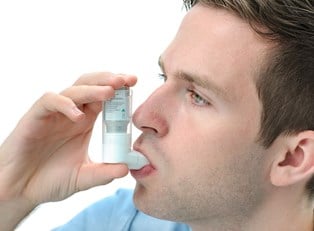Asthma in children is commonly associated with wheezing, but symptoms can also include coughing, shortness of breath, and recurrent bronchitis. Diagnosing the exact cause of asthma in children can prove difficult as more than one factor may be present in a child. An allergist will be able to determine if your child’s respiratory issues are asthma-related. Although the illness is not currently curable, it can be controlled in many instances. Additionally, some children outgrow their asthma symptoms over time.
Diagnosis of Asthma in Children
Your child’s allergist will need to know about your child’s episodes of coughing and wheezing as well as any other symptoms. In addition to frequency, be sure to communicate the severity of symptoms. The doctor will also ask about family history and about your living environment. Since colds and allergens are the most common triggers to asthma in children, your child’s physician may perform an allergy workup to aid in diagnosis. Other diagnostic tests may include chest x-rays or a pulmonary function test.
Treating Childhood Asthma
The best management plan for asthma varies from child to child. Your allergist will work with you in developing a treatment plan, which needs to be shared with caregivers and teachers. The plan will outline the type and frequency of medication as well as instructions on when to seek further medical assistance. Most important, this plan will help you and your child with early detection of symptoms and a way to treat them.
Medical science has made a number of recent advances in treating asthma. Maintaining a communicative relationship with your allergist will help you to ensure that your child is getting the best possible care now and continues to do so in the future. Today, childhood asthma is often treated with a combination of inhaled medication for quick relief and either inhaled or oral controller medications that relieve asthma-related inflammation.
Inhalers for Childhood Asthma
Inhalers are a common choice for treating childhood asthma, and they’ve been shown to be effective at helping kids manage the condition. However, keep in mind that not all children (especially young ones) will be able to properly operate one. Metered dose inhalers require users to simultaneously activate the device and inhale, and this task can be difficult for younger children who haven’t developed the coordination skills necessary to do this. In these cases, choosing a dry powdered inhaler may be a better option, as they only require the child to give a quick, deep inhale. While mastering the techniques necessary to use an inhaler may take a little practice for children, once they’ve grown accustomed to the devices, operating them shouldn’t be any problem at all.
Factors Influencing Childhood Asthma
A family history of allergies and asthma can affect the severity of childhood asthma as well as the possibility of outgrowing the condition. Smoking in the home can aggravate asthmatic symptoms and should be avoided. If allergies are a factor in your child’s asthma, you may need to take steps to remove pet dander, dust and other allergens from your home in an effort to manage your child’s symptoms. Remember that exercise is an important aspect of your child’s overall health, and once your child’s symptoms are under control, it is vital to encourage regular, healthy activity.




